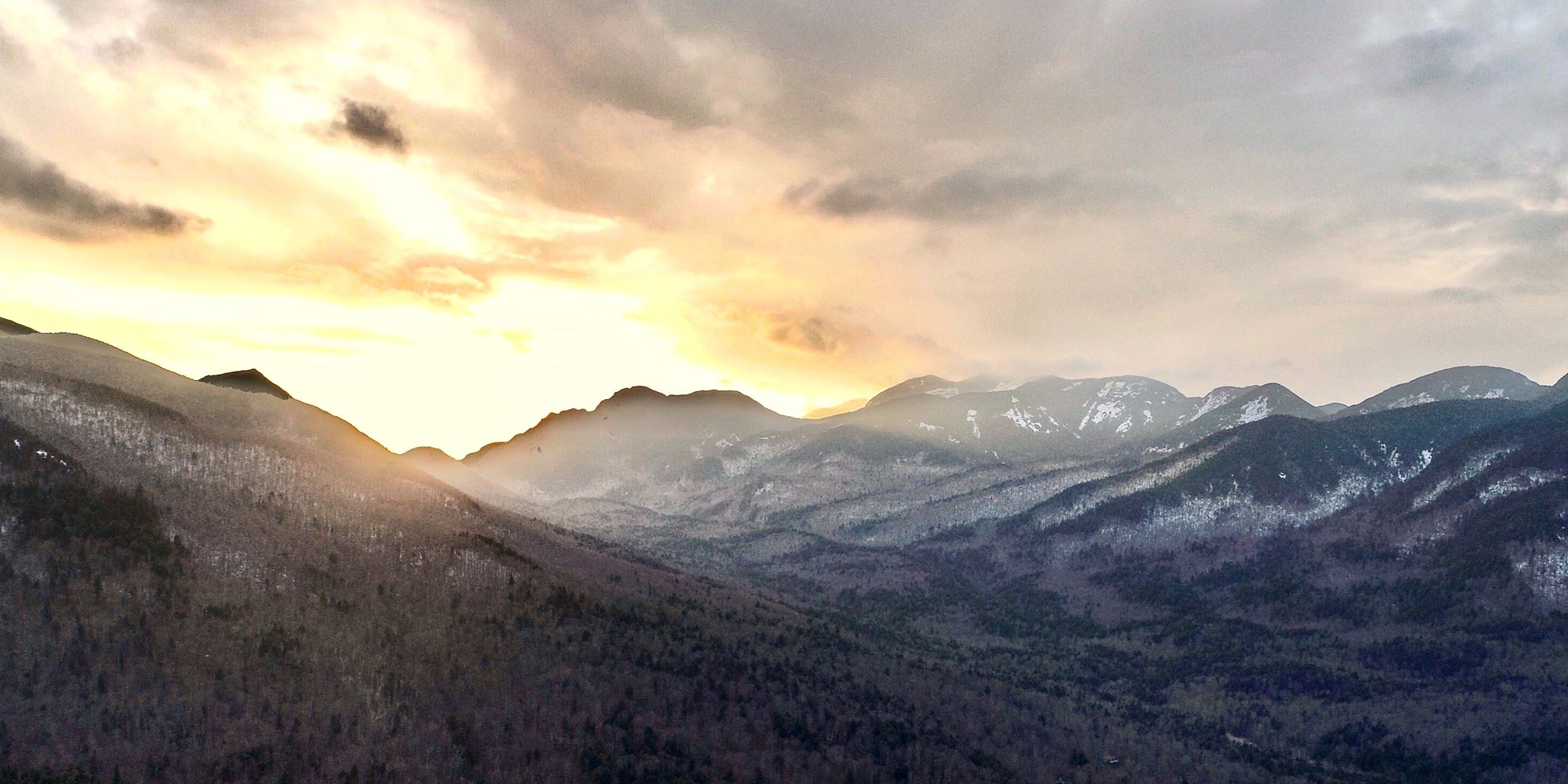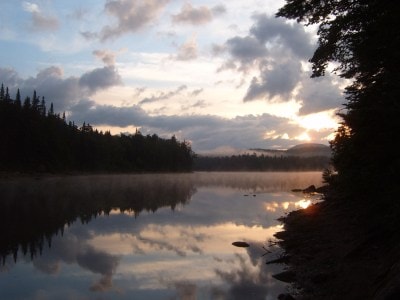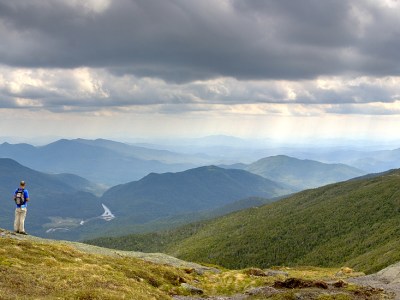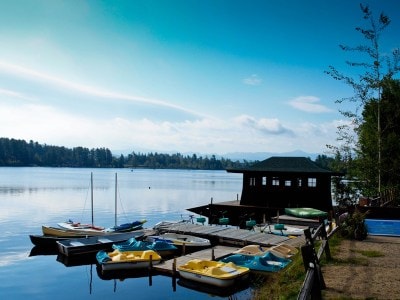
10 Things to do in the Adirondacks
Adirondack Park is more difficult to define than most state—or even national—parks. For starters, it’s massive: The greenspace, codified in the state constitution, protects roughly six million acres of upstate New York, meaning it’s larger than Yosemite, Yellowstone, Glacier, Grand Canyon and Great Smoky Mountains national parks. Combined. It doesn’t look much like a park either. Instead of entrance gates or a tour road, you simply pass a big brown sign on the highway, and its vast tracts of wilderness are dotted with towns, homes and businesses. But the opportunities for adventure are as varied as the terrain. Rocky summits, interconnected ponds and rivers, oceanlike lakes, beaten-down alpine tundra—it’s all there, and it’s all just a four-hour drive due north of New York City.
In fact, it’s something of a miracle that an area this large in the middle of the Northeast, the most densely populated and arguably one of the most-exploited landscapes in the nation, is protected at all. But thanks to an 1894 amendment to the state constitution designating the Adirondacks as “forever wild,” their hiking routes, campgrounds, climbing crags, mountain peaks and paddle trails have been a public playground for more than 125 years. So whether you call the region home, like me, or are just swinging through, there’s no shortage of ways to enjoy one of America’s original public lands.
1. High Peaks Wilderness
The High Peaks Region, two hours due north of Albany, is the beating heart of the Adirondacks, geographically and metaphorically. Much of it is state-designated wilderness, meaning it’s one of the most impenetrable forests in the Northeast, and summiting the 46 4,000-plus-foot mountains (more or less. As surveying has improved, a few have shrunk) that give the region its name is not only a local tradition, it’s one of the country’s premier peakbagging checklists. Summit every mountain on the list and you’ll be granted entry into the exclusive Adirondack 46ers club. Don’t have that kind of time? You can tackle three mountains in one go by stringing together Iroquois, Algonquin, and Wright peaks into a single 9.2-mile mission. The hike takes you from deep in the forest to delicate alpine tundra and exposed domelike mountain tops. All three summits are in the middle of the High Peaks, and the views span from Mount Marcy, the highest peak in the Empire State, in the east to the remote Seward Range in the west.
2. Noon Mark Diner
Conveniently located in Keene Valley, the High Peaks’ gateway town, Noon Mark Diner is a favorite pitstop en route to the trailhead. Grabbing one of its hearty breakfast sandwiches to go has gotten me through more than one alpine start (my personal favorite, the “Edna,” features scrambled egg and sausage on a hearth roll), but the shop is really known for its fresh pies. Good luck getting one home intact with the smell of apples, blueberries or banana cream, all wrapped in a homemade crust, wafting up from your back seat.
3. Seven Carries Canoe Route
In the Saint Regis Canoe Area near the towns of Saranac Lake and Paul Smiths, 50 ponds break up the vast swath of dark-green canopy, and one of the best ways to explore them is on the historic Seven Carries Canoe Route. Starting near Saranac Inn, you’ll paddle and haul your canoe or kayak across seven bodies of water and six portages (the original route included an additional pond). Don’t worry: The portages are all less than half a mile and many can be completed without unloading your boat. Spend a night camped out on an island in the middle of Saint Regis Pond, one of the route’s most isolated water bodies, and listen to the eerie call of the lake’s loons—my all-time favorite sound. Take out on the Paul Smith’s College campus and shuttle back to the start.
4. Hadley Mountain Fire Tower
My love of hiking came from trekking to the old fire towers that dot the Adirondacks as a kid. Now that aerial and satellite imagery has replaced the need for humans to safeguard the area’s once-precious lumber economy, many of the towers, complete with mapping tables and observer’s cabins, have become a target for hikers—the Adirondack Mountain Club has even compiled them into another checklist. Hadley Mountain, in the southern foothills of the Adirondacks, was where I got my start, thanks in part to the short-but-steep 3-mile round-trip. The summit (which was once laid bare by forest fire itself) and the tower both reward with views of nearby Great Sacandaga Lake to the south, and on a clear day, you can even spot the High Peaks roughly 50 miles to the north.
5. Lake Placid Pub and Brewery
When it’s time to fuel up or grab a drink, you can’t find a bad meal or pint in bustling Lake Placid. My favorite? Lake Placid Pub and Brewery, which has a slew of sandwiches and burgers, any of which can be washed down with the bar’s staple Ubu Ale, a strong English-style ale. The publike atmosphere is perfect for watching a rowdy hockey game with the area’s loyal fans (the town is where the U.S. national hockey team earned an improbable victory over the heavily favored Soviets in 1980 after all), or head upstairs, where a relaxing hangout space makes for a nice escape.
6. Northville-Placid Trail

A misty morning at Cedar Lakes along the Northville-Placid Trail. (Photo Credit: Michael Stokes under CC BY 2.0
There’s really no better way to get to know the ’Daks, as the locals call the mountains, than hiking the 140-mile Northville-Placid Trail. The route winds nearly the length of the park from Northville to Lake Placid through nearly every environment the Adirondacks have to offer from forested river valleys to bucolic mountain towns. And thanks to the Adirondack lean-tos, the small, ubiquitous three-sided shelters with pitched roofs that dot the route (and much of the rest of the park), you can tackle the whole trail and still sleep with a roof over your head. The shelters are first-come, first-serve and fit roughly eight people, so carrying a backup shelter isn’t a bad idea, but plan to spend the night at the West Lake, Carry or Tirrell Pond lean-tos if you can. They each sport waterfront locales and front-porch vistas.
7. Lake George
It’s easy to understand why Thomas Jefferson referred to 30-mile-long Lake George as “without comparison, the most beautiful water I ever saw.” And bordered by mountains on all sides, dotted with islands and filled with crystal clear cold water, there’s no shortage of ways to explore it. If you have access to a boat, spend a night in the Lake George Islands Campgrounds, a melange of islands dotted with pristine, water-accessed campsites. Or head to Rogers Rock Campground, on the lake’s northern end, and snag one of the 332 tent and RV sites. Beside the water, the big draw is its namesake 700-foot-tall stone slab which, as legend has it, a colonial soldier once slid down into the lake to escape his capteurs during the French and Indian War. (Explore nearby Fort William Henry and Fort Ticonderoga to learn more about the region’s colonial past.) If you’re a climber, you can reverse course and scale the giant slab on Little Finger, a classic three-pitch, 5.5 trad route with unending views over the water.
8. Chapel Pond
Anorthosite, a rare, granitelike exfoliating rock, makes up most of the region, including the High Peaks. It also makes for enjoyable climbing. The area around Keene Valley is a hot spot for moderate trad climbs like the 5.5, eight-pitch Regular Route on the Chapel Pond Slabs or Frosted Bug on the Beer Walls, a 5.9 crack-in-corner pitch. Come in the winter, and the ’Daks are home to some of the best moderate ice in the country. While exposed and long, the aforementioned slabs are rated WI2+ and don’t require any advanced techniques. For more experienced ice climbers, WI3 Chouinard’s Gully and WI4 Crystal Ice Tower are short but steep classics.
9. Adirondack Experience Museum
Smack in the middle of the vast park on the shores of Blue Mountain Lake is what locals call the Smithsonian of the Adirondacks: the expansive Adirondack Experience museum, which is dedicated to cataloging life in the region. From May to October, explore the 121-acre, open-air campus and view old guideboats and canoes, see what life was like in a logging camp, and wander galleries and exhibits filled with artifacts from the ’Daks rich history and environment. (If you have kids, be sure to stop by the visitor center for the daily scavenger hunt.)
10. Camp Santanoni Historic Area
The Adirondacks’ reputation as the rugged back yard of early America was especially true to the wealthy elites of New York and Albany. Beginning in the mid- to late-1800s, they began buying up large swaths of land to build the elaborate mansions known as Great Camps to escape the city and impress their guests. Today, many are open to the public. One option is to hike or cross-country ski the 5-mile gravel trail from the town of Newcomb to Camp Santanoni, a sprawling historic site that includes a main lodge, artist’s studio, boathouse and more left behind by its late 19th-century builder, businessman and banker Robert Pruyn. One of the most spectacular Great Camps in the park, Santanoni once hosted President Theodore Roosevelt.
1. High Peaks Wilderness
The High Peaks Region, two hours due north of Albany, is the beating heart of the Adirondacks, geographically and metaphorically. Much of it is state-designated wilderness, meaning it’s one of the most impenetrable forests in the Northeast, and summiting the 46 4,000-plus-foot mountains (more or less. As surveying has improved, a few have shrunk) that give the region its name is not only a local tradition, it’s one of the country’s premier peakbagging checklists. Summit every mountain on the list and you’ll be granted entry into the exclusive Adirondack 46ers club. Don’t have that kind of time? You can tackle three mountains in one go by stringing together Iroquois, Algonquin, and Wright peaks into a single 9.2-mile mission. The hike takes you from deep in the forest to delicate alpine tundra and exposed domelike mountain tops. All three summits are in the middle of the High Peaks, and the views span from Mount Marcy, the highest peak in the Empire State, in the east to the remote Seward Range in the west.
2. Noon Mark Diner
Conveniently located in Keene Valley, the High Peaks’ gateway town, Noon Mark Diner is a favorite pitstop en route to the trailhead. Grabbing one of its hearty breakfast sandwiches to go has gotten me through more than one alpine start (my personal favorite, the “Edna,” features scrambled egg and sausage on a hearth roll), but the shop is really known for its fresh pies. Good luck getting one home intact with the smell of apples, blueberries or banana cream, all wrapped in a homemade crust, wafting up from your back seat.
3. Seven Carries Canoe Route
In the Saint Regis Canoe Area near the towns of Saranac Lake and Paul Smiths, 50 ponds break up the vast swath of dark-green canopy, and one of the best ways to explore them is on the historic Seven Carries Canoe Route. Starting near Saranac Inn, you’ll paddle and haul your canoe or kayak across seven bodies of water and six portages (the original route included an additional pond). Don’t worry: The portages are all less than half a mile and many can be completed without unloading your boat. Spend a night camped out on an island in the middle of Saint Regis Pond, one of the route’s most isolated water bodies, and listen to the eerie call of the lake’s loons—my all-time favorite sound. Take out on the Paul Smith’s College campus and shuttle back to the start.
4. Hadley Mountain Fire Tower
My love of hiking came from trekking to the old fire towers that dot the Adirondacks as a kid. Now that aerial and satellite imagery has replaced the need for humans to safeguard the area’s once-precious lumber economy, many of the towers, complete with mapping tables and observer’s cabins, have become a target for hikers—the Adirondack Mountain Club has even compiled them into another checklist. Hadley Mountain, in the southern foothills of the Adirondacks, was where I got my start, thanks in part to the short-but-steep 3-mile round-trip. The summit (which was once laid bare by forest fire itself) and the tower both reward with views of nearby Great Sacandaga Lake to the south, and on a clear day, you can even spot the High Peaks roughly 50 miles to the north.
5. Lake Placid Pub and Brewery
When it’s time to fuel up or grab a drink, you can’t find a bad meal or pint in bustling Lake Placid. My favorite? Lake Placid Pub and Brewery, which has a slew of sandwiches and burgers, any of which can be washed down with the bar’s staple Ubu Ale, a strong English-style ale. The publike atmosphere is perfect for watching a rowdy hockey game with the area’s loyal fans (the town is where the U.S. national hockey team earned an improbable victory over the heavily favored Soviets in 1980 after all), or head upstairs, where a relaxing hangout space makes for a nice escape.
6. Northville-Placid Trail

A misty morning at Cedar Lakes along the Northville-Placid Trail. (Photo Credit: Michael Stokes under CC BY 2.0
There’s really no better way to get to know the ’Daks, as the locals call the mountains, than hiking the 140-mile Northville-Placid Trail. The route winds nearly the length of the park from Northville to Lake Placid through nearly every environment the Adirondacks have to offer from forested river valleys to bucolic mountain towns. And thanks to the Adirondack lean-tos, the small, ubiquitous three-sided shelters with pitched roofs that dot the route (and much of the rest of the park), you can tackle the whole trail and still sleep with a roof over your head. The shelters are first-come, first-serve and fit roughly eight people, so carrying a backup shelter isn’t a bad idea, but plan to spend the night at the West Lake, Carry or Tirrell Pond lean-tos if you can. They each sport waterfront locales and front-porch vistas.
7. Lake George
It’s easy to understand why Thomas Jefferson referred to 30-mile-long Lake George as “without comparison, the most beautiful water I ever saw.” And bordered by mountains on all sides, dotted with islands and filled with crystal clear cold water, there’s no shortage of ways to explore it. If you have access to a boat, spend a night in the Lake George Islands Campgrounds, a melange of islands dotted with pristine, water-accessed campsites. Or head to Rogers Rock Campground, on the lake’s northern end, and snag one of the 332 tent and RV sites. Beside the water, the big draw is its namesake 700-foot-tall stone slab which, as legend has it, a colonial soldier once slid down into the lake to escape his capteurs during the French and Indian War. (Explore nearby Fort William Henry and Fort Ticonderoga to learn more about the region’s colonial past.) If you’re a climber, you can reverse course and scale the giant slab on Little Finger, a classic three-pitch, 5.5 trad route with unending views over the water.
8. Chapel Pond
Anorthosite, a rare, granitelike exfoliating rock, makes up most of the region, including the High Peaks. It also makes for enjoyable climbing. The area around Keene Valley is a hot spot for moderate trad climbs like the 5.5, eight-pitch Regular Route on the Chapel Pond Slabs or Frosted Bug on the Beer Walls, a 5.9 crack-in-corner pitch. Come in the winter, and the ’Daks are home to some of the best moderate ice in the country. While exposed and long, the aforementioned slabs are rated WI2+ and don’t require any advanced techniques. For more experienced ice climbers, WI3 Chouinard’s Gully and WI4 Crystal Ice Tower are short but steep classics.
9. Adirondack Experience Museum
Smack in the middle of the vast park on the shores of Blue Mountain Lake is what locals call the Smithsonian of the Adirondacks: the expansive Adirondack Experience museum, which is dedicated to cataloging life in the region. From May to October, explore the 121-acre, open-air campus and view old guideboats and canoes, see what life was like in a logging camp, and wander galleries and exhibits filled with artifacts from the ’Daks rich history and environment. (If you have kids, be sure to stop by the visitor center for the daily scavenger hunt.)
10. Camp Santanoni Historic Area
The Adirondacks’ reputation as the rugged back yard of early America was especially true to the wealthy elites of New York and Albany. Beginning in the mid- to late-1800s, they began buying up large swaths of land to build the elaborate mansions known as Great Camps to escape the city and impress their guests. Today, many are open to the public. One option is to hike or cross-country ski the 5-mile gravel trail from the town of Newcomb to Camp Santanoni, a sprawling historic site that includes a main lodge, artist’s studio, boathouse and more left behind by its late 19th-century builder, businessman and banker Robert Pruyn. One of the most spectacular Great Camps in the park, Santanoni once hosted President Theodore Roosevelt.

